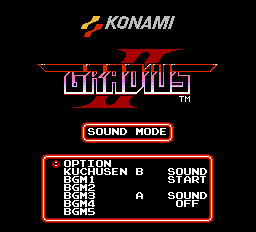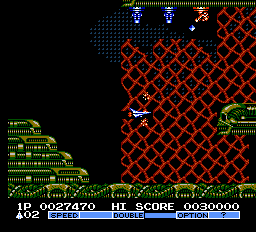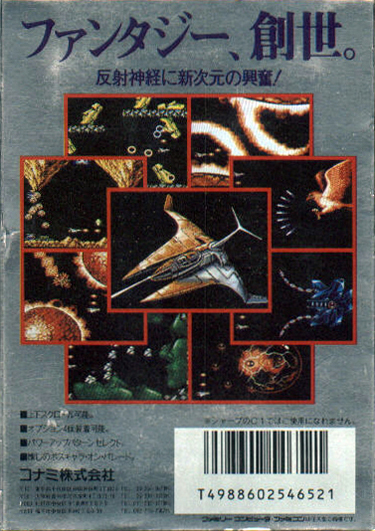
Jedi QuestMaster
Daunting alien-like insect creatures, dragons, a phoenix, and even a giant cranium skeleton will engulf players into this mysterious universe.
Review
Intro (Storyline) 3.0
After the defeat of the Bacterion Empire, another superior rises to power. By the leadership of Gofer, the Bacterion army returns for another aggression. Does this seem a little familiar? It's pretty much the tale of every other ordinary sequel that's ever been contemplated. At least they make the inclusion of a fresh head villain in this one.
Graphics 5.0
Glancing at the back of the box, one would question whether the screenshots were really taken from a Famicom game at all. There have been cases where a publisher would falsely advertise in this field...but not Konami! For what is seen here is truly a foretaste of 8-bit spectacularity.
Some recognizable enemies reenter the haze better rendered, as well as a new onslaught of destructive forces, small and large. Meticulous detail does not cease, from the comprehensive introduction image to the astounding final boss. Evocative landscapes, such as the revisited Moai stage and the beautiful crystal world are nothing short of impressive, and strange life forms: Daunting alien-like insect creatures, dragons, a phoenix, and even a giant cranium skeleton will engulf players into this mysterious universe despite the Family Computer's sprite-flickering limitations.
Audio 5.0
If it has to be something that every Konami title can guarantee its audience, besides excellent graphics, it would be the company's trademark sound. PCM voices are included for indication between the different power-ups as they are acquired. So when a 'MISSILE' is procured, a voice says "Missile," as with other upgrades. So there's no need to freak out wondering where the hell all those hard-earned power-up capsules went to, assuming there isn't a ton of overshadowing commotion going on at the moment. The noise of the weaponry itself is also remarkable with some fresh tones like the laser and instantly recognizable ones like the resonance of the beam from the original. On top of that, many Contra-esque sounds are present.
As for the music, can we expect anything less from the people who brought us Castlevania? Motoaki Furukawa's compositions, and the arrangers' work are incredible. The transition from the arcade is nearly perfect, considering the console's restricted five channels (and every single one of them is employed to the fullest degree). Square waves successfully resemble flutes and strings, while the signature PCM drums add the final Kukeiha touch. One renowned tune from the former Gradius cleverly sneaks its way into this soundtrack as well.
Gameplay 4.5
Fans of the series will without a doubt grasp the technique. The difficulty starts out modest and eventually rises to extremely hostile conditions. Not only is the Viper equipped with its entire set of previous armaments, virtually untampered with, but incorporates three additional configurations to choose from. The gameplay is practically the same, which can be viewed as both good and bad. The Vic must first be "leveled up" to reach peak performance, which is usually done through each intro phase. The path is far-reaching, rival ships are numerous and varied, and the combat zone is quite intensive. The setback with this is the slowdown caused by the many sprites present at once. It becomes very noticeable in the course of the crystal planet portion of Stage 3 where loads of rocks flood the passageway. Maintaining a full aptitude of artillery, constantly firing, doesn't help either. Another slight inconvenience is the absence of the heads up display during critical boss battles. The purpose behind its disappearance is probably to focus on the visual support of the adversary onscreen; however, upgrades aren't usually around under these conditions, so it's mainly justified.
Controls 5.0
The gamepad buttons are straightforward: push B to shoot and A to select an item from the power meter. This setup is actually opposite that from the first Gradius, yet feels natural in this installment. This time the ship is faster at start, not rendering the vessel totally defenseless after an abrupt death. Power-ups are improved with the ability to further augment them above normal capacity. For instance, typical double fire increases to rapid double fire, standard lasers enhance to uninterrupted lasers, and multiple options advance to multiple revolving options. Less likely will there be a situation where all weapons are absolutely maxed out.
Frustrations 4.5
Taking into account the single-hit deaths, the journey to Gofer is one tedious task. The levels are basically mapped out to allow the player to build up strength before the intense portions, which can be a major annoyance after losing a life and being completely susceptible to minor attacks in the middle of the fray. At times, it seems better to get a "Game Over" to restart a level and build up again. Although a problem, this isn't too much of a hindrance, considering there's an infinite amount of continues at hand. An obvious grievance is the constant flickering and slowdown in the gameplay. In extremely congested situations enemy fire may barely be visible -- an unjust disadvantage. On the other hand, the circumstances may be easier a second time around due to having attained more firepower.
Fun Factor 5.0
Anyone who hasn't once played anything in the Gradius collection can pick up quickly on the mechanics. The relentless challenge will have seasoned players coming back for more. The challenge, although excruciating, is made less menacing by including continues. And a larger selection of items will fit everyone's individual preferences. Whether for a simple, casual time-killer, or as a hardcore test of determination, the title is flexibly suitable.
Overall 4.0
Unreleased outside Japan, Gradius II raised the quality of Nintendo's 8-bit system to higher standards, boasting first rate visual and audio properties, and delivering a truly distinct, vibrant experience. A recommended title for Famicom collectors worldwide; with the absence of an in-game storyline, there are no apparent language barriers. Then again, obtaining the freakin' thing is a barrier in itself. The loose cartridge alone can sell for relatively steep prices. On another note, there's always the virtual console...
As to why this follow-up never saw the light of the Nintendo Entertainment System could be due to numerous factors. The board in the cartridge itself, for one thing, utilizes a unique chip exclusive to Konami: the VRC4. The cost of managing this board may have stifled all hope and interest in a U.S. version. Conversely, the Famicom version of Contra also contained a VRC, that, when ported to the NES, was replaced by a common mapper, in turn, diminishing much of the graphical effects. Yet, even lacking its special multi-memory controller (MMC), Contra is still known for what it was good for then. Even still, reproductions of unusual mapper carts have been made. Another reason for the inattention could be the fact that Nintendo of America put a cap on the amount of releases a third party company could have each year, resulting in the creation of subsidiary businesses, such as Ultra Games and *GASP* LJN Ltd. With this strategy, Konami of America was able to release their own quantity, while their spin-off company, Ultra, produced their own allotment as well. Also, Life Force (Salamander) was marketed as the sequel in North America, substituting for Gradius II. Finally, the circumstances could be seen in the same light as Super Mario Bros. 2 with the discouraging frustration of the gameplay being deemed "too hard" for American consumers. Yet, that is highly doubtful judging from the difficulties of Life Force and the Gradius series in general. They are equally, if not more, challenging. Why we didn't experience this gem in the late '80s remains unknown.
Hints and Cheats
Start with 30 lives: At the title screen, press up, up, down, down, left, right, left, right, B, A and then press start.
Sound test: At the title screen, hold down A and B and then press start.

![[]](https://famicomworld.com/wp-content/uploads/diskkun.png)















